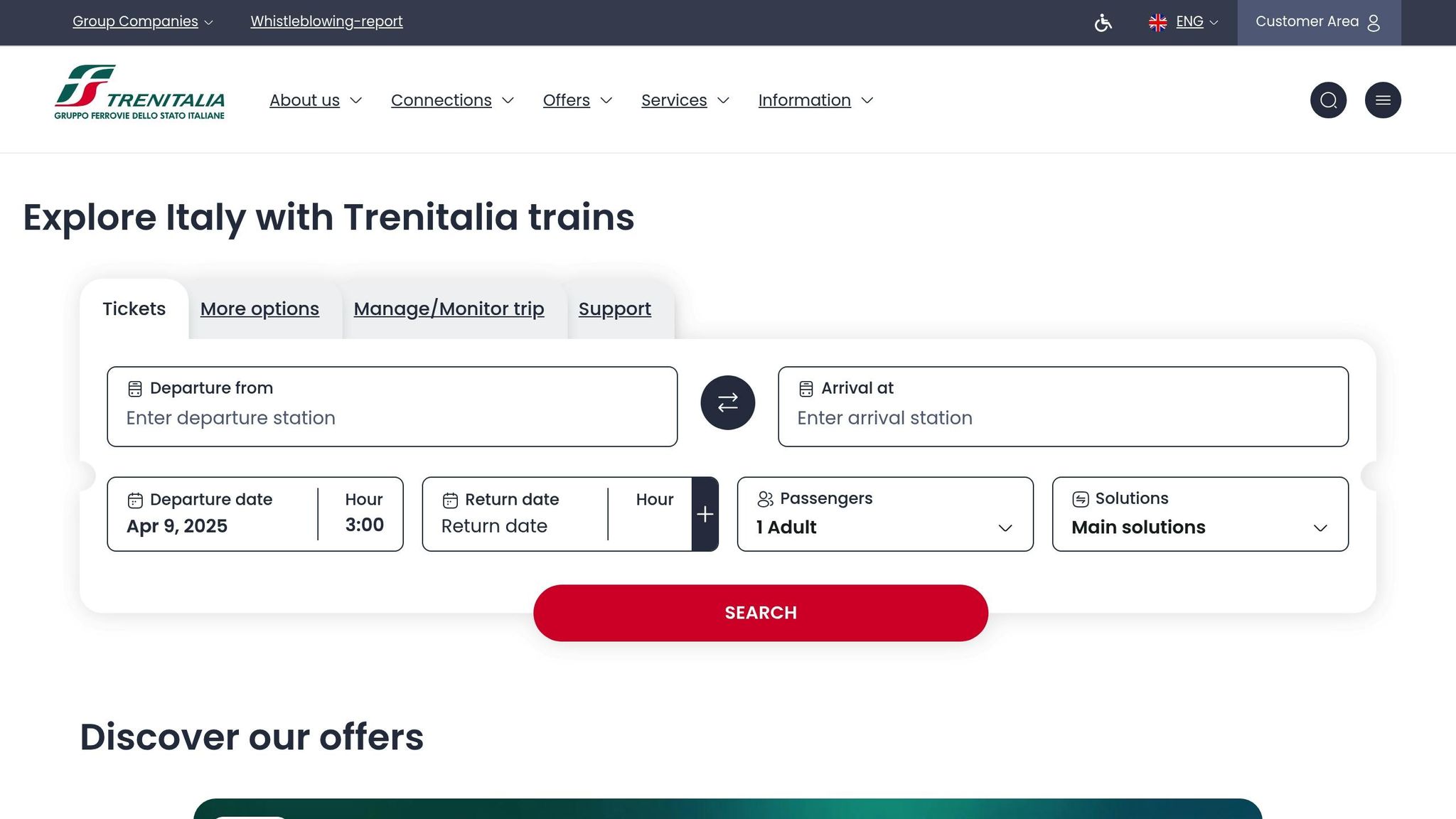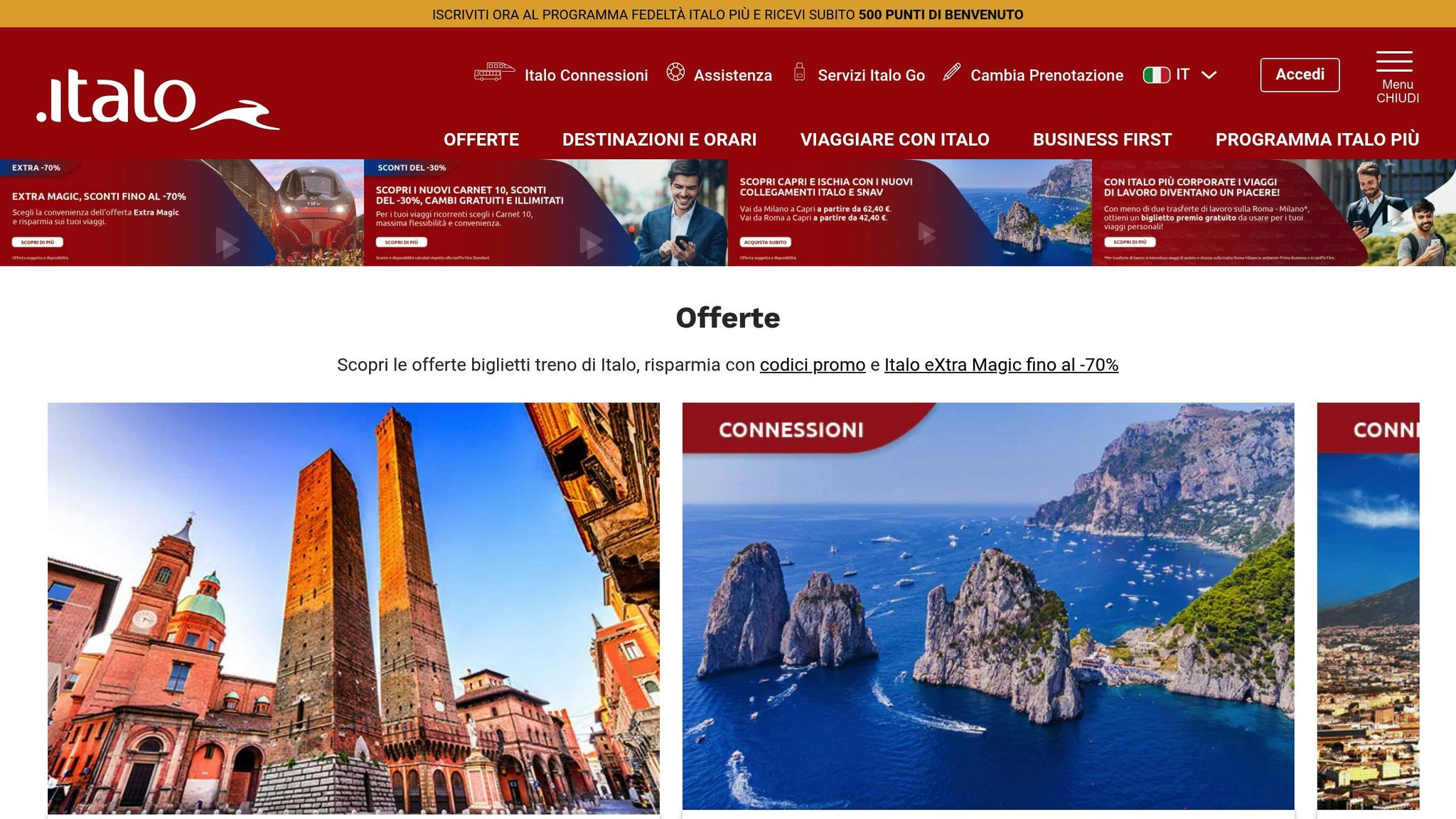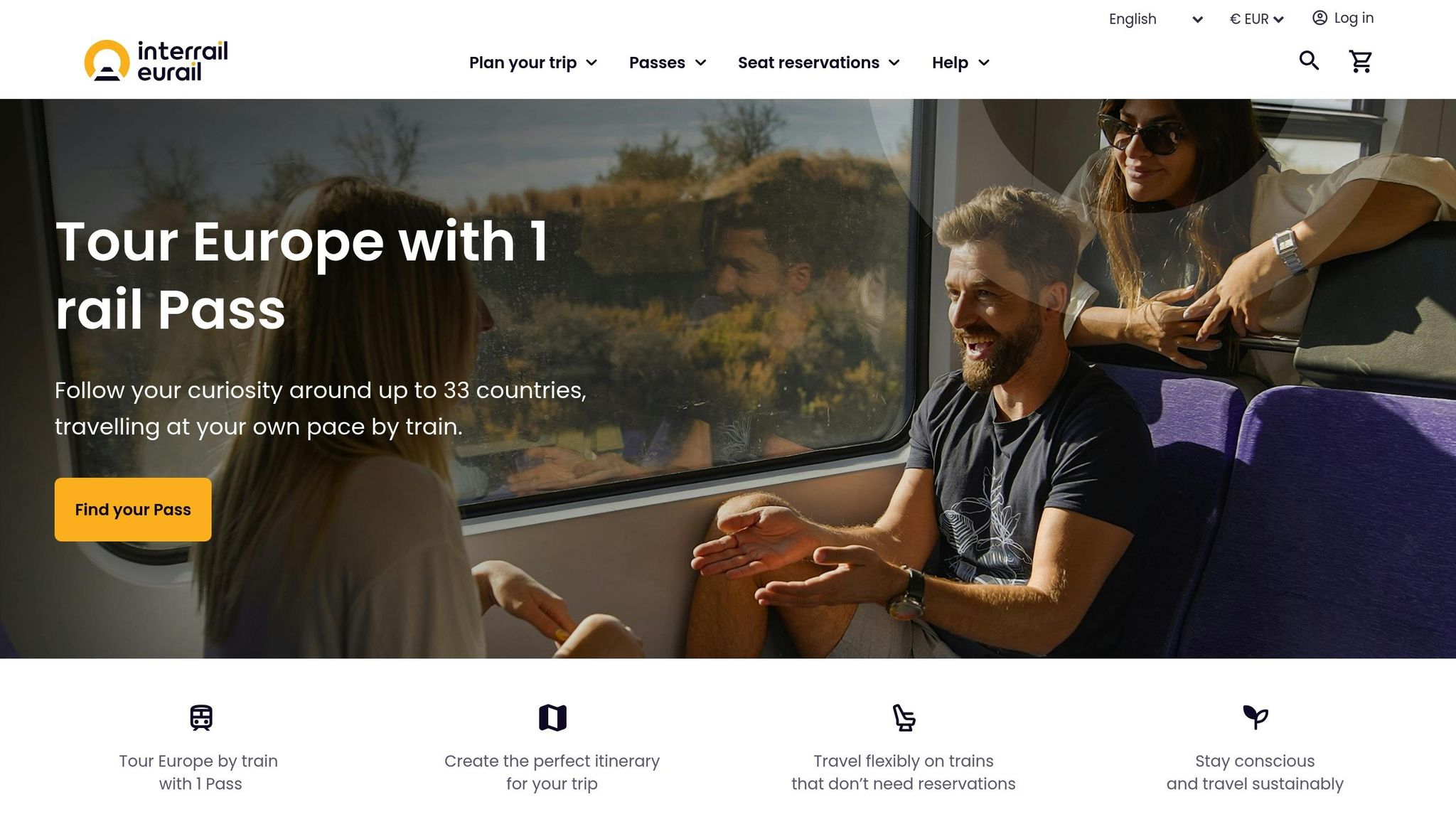Traveling from Venice to Rome by train is fast, convenient, and scenic. Here’s what you need to know:
- Fastest Option: High-speed trains like Frecciarossa and Italo take about 3 hours and 47 minutes to cover the 327-mile journey.
- Ticket Prices: Start at $30.75 for high-speed trains, $12 for Intercity trains, and $24.15 for night trains.
- Daily Departures: Around 38 trains run daily, with services available from early morning to late evening.
- Comfort Options: Choose from Standard, First Class, or luxurious night train cabins with amenities like Wi-Fi, power outlets, and snacks.
- Scenic Route: Enjoy views of Emilia-Romagna and Tuscany along the way.
For budget-friendly travel, book early to secure discounted fares or opt for slower Intercity trains. Both Trenitalia and Italo offer flexible schedules and a range of services to suit your preferences.
Train Ticket Types
Standard Class
Frecciarossa’s Standard Class offers basic seating equipped with electrical and USB outlets, free WiFi, and access to the FRECCE Portal. There’s also a café/snack bar on board. Tickets start at $30.75 [2].
If you’re looking to save money, Intercity trains provide Second Class service starting at $12. While these trains take longer than the Frecciarossa, they are a more budget-friendly choice [2].
For those wanting a bit more comfort, First Class options are also available.
First Class
Frecciarossa First Class comes in several tiers. Premium offers reclining leather seats and complimentary snacks. Business provides more space and upgraded refreshments, with the option for a quieter trip in the Business Area Silenzio. Executive takes it up a notch with luxurious seating and at-seat service [2].
On Intercity trains, First Class features wider seats and extra legroom compared to Second Class [2].
Night Trains
Intercity Notte night trains cater to overnight travelers with four accommodation choices. Basic seating is available starting at $24.15 [2]. Comfort berths feature four-bed cabins with bedding, an amenity kit, and a light breakfast [2]. The Deluxe cabin offers a two-bed setup with premium bedding, gender-specific amenity kits, and a full breakfast [2]. For the ultimate experience, the Excelsior cabin includes a spacious bed for one or two passengers, a private shower, welcome snacks, drinks, and breakfast served in bed [2].
How to Take the Train from Venice to Rome
Train Companies
Two train operators provide services between Venice and Rome, each offering different levels of comfort and amenities.
Trenitalia Services
Trenitalia, Italy’s national railway company, runs about 38 trains daily on the Venice to Rome route [1]. Here’s what they offer:
- Frecciarossa High-Speed Trains: These cover the 327-mile trip in just 3 hours and 47 minutes. They feature classes ranging from Standard to Executive, along with onboard WiFi.
- Intercity Trains: Available with both First and Second Class seating options.
- Regional Services: These trains make more stops, providing access to smaller towns along the way.
Italo Services
Italo operates over 20 high-speed trains daily between Venice and Rome [4]. Their service classes include:
| Service Class | Features |
|---|---|
| Lounge Italo Club | Spacious armchairs, dedicated catering, fast track access, newspapers, personal screens, free WiFi |
| Prima Business Class | Fast track access, a welcome service, newspapers, reclining leather seats, extra space, free WiFi |
| Smart Class | Reclining leather seats and free WiFi |
Ticket prices start at $32.50, with fares ranging between $19.50 and $98, depending on the class and how early you book [4].
Next, let’s look at the different route options for this journey.
Route Options
Travelers heading from Venice to Rome have several ways to make the journey, depending on their preferences and schedule.
Fast Direct Trains
High-speed trains cover the 327-mile distance in just about 3 hours and 47 minutes, with no need for transfers [1]. Trenitalia’s Frecciarossa and Italo’s services are the main operators, stopping only at key stations along the way.
Here’s a quick comparison of the main travel options:
| Train Type | Journey Time | Distance |
|---|---|---|
| Direct High-Speed | 3h 47m | 327 miles |
| Routes with Stops | Longer than direct | 327 miles |
| Night Train | 6–8 hours | 327 miles |
Below are more details about each option.
Routes with Stops
For those who want to explore more of Italy during their trip, routes with stops are a great choice. These trains pause at major cities like:
- Bologna – Known as a key railway hub and cultural hotspot.
- Florence – Famous for its art, history, and stunning architecture.
- Padua – Home to one of the oldest universities in the world.
Although these routes take longer than direct trains, they let you experience additional destinations along the way [1].
Night Train Routes
Overnight trains are perfect if you’d rather sleep through the journey. These services take 6–8 hours to cover the 327 miles, offering a range of seating and sleeping options [2]. From standard seats to private cabins with added comforts, there’s something for every type of traveler. For more details, check out the Ticket Types section.
How to Buy Tickets
Company Websites
You can buy tickets directly from the train operators’ websites:
- Trenitalia: Enter Venice and Rome as your departure and arrival stations, choose your travel dates, and manage bookings easily [3].
- Italo: Italo Treno’s website lets you book tickets without extra service fees. You can also use promo codes and pick flexible travel dates [5].
Other Booking Options
Tickets are also available at station ticket counters. If you buy tickets this way, they remain valid for up to 4 hours after the scheduled departure time [6]. This option provides added convenience for travelers with varying schedules.
Ticket Prices
Ticket prices depend on the type of train service. High-speed trains have prices that change based on demand and how far in advance you book, while regional trains have fixed rates [6]. Booking online early is often the best way to lock in lower prices [6].
Ways to Save Money
Early Booking Deals
You can snag high-speed tickets on Frecciarossa services for as low as $30.75 if you book early [2]. Ticket prices increase as the departure date approaches, so locking in your fare ahead of time is key. Trenitalia’s Super Economy and Italo’s Low Cost tickets offer the cheapest rates, but keep in mind – they’re non-refundable and require flexibility with travel times [7].
On top of these options, there are several programs and group deals to help you save even more.
Rewards Programs
Here are some discount cards that can lower your travel costs:
- Carta Verde (ages 12–26): Costs $44 per year and gives a 10% discount on base national train tickets [8].
- Carta Argento (ages 60+): Costs $33 per year and offers discounts on Intercity, Intercity Notte, and regional trains. It’s free for travelers aged 75 and older [8].
- Carta Blu: Provides free travel for companions of disabled travelers [8].
Group Discounts
Traveling in a group? There are discounts for that too:
- Children under 4: Travel for free without a seat.
- Ages 4–15: Get 50% off base fares for national trains [8].
- School Groups: The "Scuolaintreno" program offers big savings. For example, a Florence school group of 50 saved $2,970 on a Rome trip in July 2023 [8].
- Groups of 10 or more: Special rates are available, and you can reserve seats with a deposit [8].
For even more savings, consider regional or Intercity services. Regional trains are budget-friendly, while high-speed fares can climb as high as $99 during peak times [2]. These strategies make it easier to stick to your budget while enjoying flexible travel options.
Train Times
Daily Schedule
Trains between Venice Santa Lucia and Rome Termini run consistently throughout the day. The first train departs at 12:01 a.m., and the last service leaves at 11:11 p.m. [1]. Covering a distance of 327 miles, these trains frequently stop at major cities along the way, offering plenty of options for travelers.
Number of Trains
With an average of 38 trains running daily between Venice and Rome, passengers have plenty of choices. However, fewer trains may operate on holidays, which can result in longer travel times [1].
Trip Length
Travel times vary depending on the type of train, as speed and stops differ. The quickest trains complete the journey in about 3 hours and 47 minutes, reaching speeds of up to 190 mph [1][9].
| Train Type | Features | Travel Time |
|---|---|---|
| High-Speed Direct | No transfers needed | 3h 47m |
| Services with Stops | Stops at key cities | 4h+ |
| Regional Trains | Includes transfers | Varies |
Direct high-speed trains are the fastest and most reliable. Meanwhile, regional trains, though slower and requiring transfers, are often more budget-friendly. These options cater to a range of preferences and budgets [1].
Extra Costs and Rules
Seat Reservation Fees
Here’s a breakdown of seat reservation fees (in U.S. dollars):
| Train Type | Class | Reservation Fee |
|---|---|---|
| Frecciarossa/Frecciargento | First Class | $14.30 |
| Frecciarossa/Frecciargento | Second Class | $14.30 |
| Frecciabianca | First Class | $11.00 |
| Frecciabianca | Second Class | $11.00 |
| InterCity | Both Classes | $3.30 |
If you make a reservation at an Italian station and cancel it before departure, you can get 80% of the fee refunded [10]. Knowing these fees can help you better plan your travel expenses.
Refund Rules
Here’s an overview of cancellation and refund policies for different ticket types:
- Super-Economy Tickets: No refunds or changes allowed.
- Economy Tickets: One change is allowed, but cancellations are not permitted.
- Base/Normal Tickets: Cancellations are allowed, but there’s a 20% penalty.
- Go Fares: Cancellations are allowed with a 50% penalty if done at least three days before travel.
Keep in mind, no changes or cancellations are allowed within 24 hours of departure. If your train gets canceled, Trenitalia will try to rebook you on the next available service. If no alternative is available, you can request a cancellation and refund at the station [11].
Rail Pass Fees
If you’re using a rail pass, don’t forget that reservation fees still apply and must be paid before boarding [10]. Since trains on this route are often busy – especially during summer – it’s a good idea to book your seat reservations early to avoid missing out.
Using Interrail Passes
Pass Benefits
Interrail passes make traveling between Venice and Rome convenient. With these passes, you can hop on regional trains without any extra steps. However, for high-speed, Intercity, and overnight trains, you’ll need to book a seat in advance (details below).
Here are the two main pass options:
- Interrail Italy Pass: Starting at $156, this pass provides access to Italy’s extensive rail network, including Trenitalia trains.
- Interrail Global Pass: Starting at $230, this pass covers travel not only in Italy but also across 32 other European countries.
Pass holders can also enjoy discounts on city sightseeing buses across Italy. Let’s break down the reservation rules for different train types.
Required Reservations
Knowing which trains need reservations will help you plan better. While your Interrail pass covers the base ticket price, some trains require an extra reservation fee.
| Train Type | Reservation Required | Booking Deadline |
|---|---|---|
| Regional Trains | No | N/A |
| Frecciarossa/Frecciargento | Yes | At least 3 hours before (e-tickets) |
| Intercity | Yes | At least 3 hours before (e-tickets) |
| Night Trains | Yes | 2–4 weeks in advance (paper tickets) |
Key points to remember:
- Reservations made through the Interrail system come with a $2.20 fee per passenger, per train.
- Paper tickets for night trains take 2–4 weeks to arrive, so plan ahead.
- If you’d rather skip reservation fees, stick to regional trains.
The Interrail website has a tool to check reservation requirements for specific routes. If you run into issues booking through their system, contacting Trenitalia directly is a solid alternative.
Summary
Traveling by train from Venice to Rome is a convenient way to cover the 327-mile distance. High-speed Frecciarossa trains make the trip in about 3 hours and 47 minutes [1], while Intercity and night trains take between 6 and 8 hours [2]. With around 38 daily departures [1], there are plenty of scheduling options to suit different travel plans. These consistent schedules offer a range of ticket prices and service levels.
Ticket prices vary based on train type. High-speed tickets start at about $30.75, Intercity options at $12, and night train fares at $24.15 [2].
The journey begins at Venice Santa Lucia station and ends at Roma Termini, both conveniently located in the city centers. Train travel is especially practical because of these central locations and the lack of extensive pre-departure requirements [2].
To save money, book tickets early, look for Super Economy fares (starting at $21.90 [12]), or consider night trains to combine travel and accommodation costs [12].
Modern trains come equipped with amenities like air conditioning, electrical outlets, and Wi-Fi [1]. For more information on ticket options, booking tips, and travel advice, check the sections above. Train travel between Venice and Rome remains a practical and budget-friendly choice.



